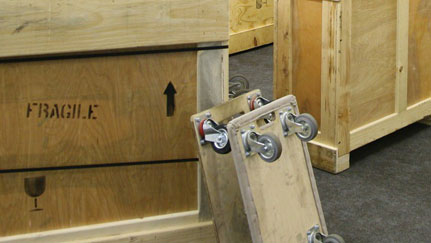Loading...
Storing and shipping artwork

Among the greatest risk for a piece of art is the moving process. Whether shipping or storing, accidents can occur, leaving your artwork vulnerable to damage or loss. When planning your next move, consider these recommendations for packing, storing and shipping artwork.
Packing artwork
Before packing your artwork, it is important to consider your shipping method. Typically, traditional pack and ship couriers such as FedEx and UPS will not pay for damages unless the packing meets their standards. If you choose this method, we recommend that you ask the courier to pack the art and purchase insurance for the full replacement price.
We suggest the following steps for packing:
- Place a heavy plastic wrap tightly over the frame so it does not touch the image or glazing.
- Cover the entire front and back in a heavy cardboard.
- Wrap the covered frame in a heavy material and place in a sturdy box with 3 inches or more packaging peanuts (or similar materials) on all sides.
- Always use museum quality wrapping materials, which are free of acids that can damage your artwork.
Depending on the size and weight of your artwork, you may consider a custom crate to better protect your artwork. Sculptures should be fully wrapped in a heavy plastic, surrounded by a cardboard enclosure and also packed with 3 inches or more of packing peanuts on all sides.
Storing artwork
- We recommend storing art in an in-home storage room without direct sunlight. While airflow around artwork is important, avoid rooms with direct paths of airflow from heating and/or air conditioning. The storage room should have gentle air flow at a constant temperature.
- Never keep framed art or sculptures on the floor. It should always be stored on racks or shelves, right side up. It is a good idea to use acid free spacing materials to separate the frames.
- Under no circumstances should bubble wrap, plastic, Styrofoam, newspaper or ordinary brown paper ever come in direct contact with your artwork.
- Basement and attics without environmental controls are not ideal for art storage due to the dramatic temperature swings in attics and dampness found in most basements.
Professional storage is recommended for art of substantial value and of great sentimental value. Self-storage units can lack adequate ventilation and may have only minimal environmental controls.
Shipping artwork
You may also want to consider hiring a professional household moving company or specialty art shipping company to transport your artwork. We recommend you consider the following:
- Specialty art shipping companies take great care of your artwork and can be found in most metropolitan areas. They generally adhere to the acid-free method of packing.
- A traditional pack and ship courier is a viable option, especially if your art will only be exposed to shipping materials for a short period of time.
- If you use a professional household moving company, we recommend that you ask your local courier to pack the artwork as outlined above, We also suggest that you place special insurance on the artwork.
Of these three options, a household company is the least desirable method for high value artwork.
Be sure to promptly uncrate or unpack your artwork once it reaches its destination.